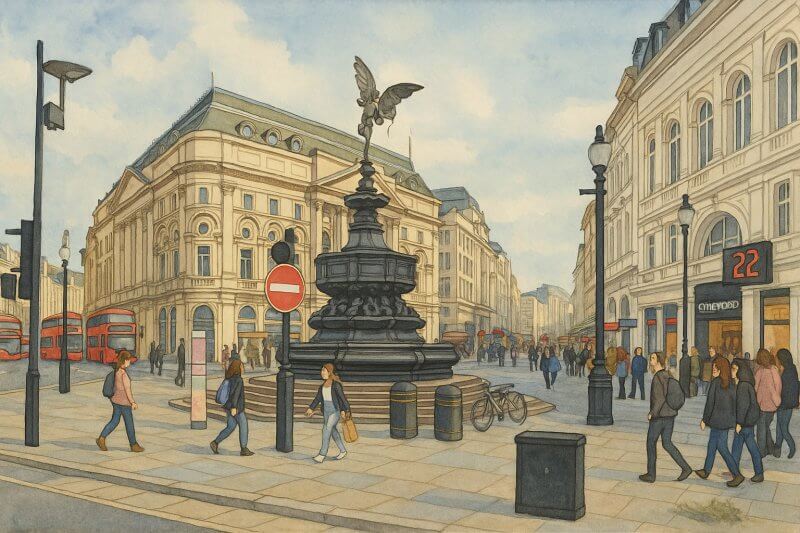
Piccadilly Circus, London
A Landmark that Captures the Heartbeat of the West End
Few places in London encapsulate the city's energy like Piccadilly Circus. With its neon lights, iconic statue, and buzzing atmosphere, this junction is more than just a place to pass through — it's a destination in its own right.Where Is Piccadilly Circus?
Piccadilly Circus is located in the heart of London’s West End, within the City of Westminster.It lies at a critical intersection where several major roads converge, making it one of the capital’s most famous and recognizable junctions.
The location is surrounded by theatres, restaurants, shops, and tourist attractions, and is just a short walk from Leicester Square, Soho, and Regent Street.
The History of Piccadilly Circus
Piccadilly Circus was created in 1819 as part of urban improvements in the growing city.The initial purpose was to connect the elegant street of Regent Street with the bustling thoroughfare of Piccadilly.
Over time, it evolved from a simple junction into a major traffic hub and cultural landmark.
The junction underwent several modifications, including the addition of Shaftesbury Avenue in the 1880s and the arrival of electric billboards in the early 20th century, transforming it into a symbol of modernity and commercial life.
Map of Piccadilly Circus, London
How Did It Get Its Name?
The name "Piccadilly" originates from a type of 17th-century collar called a "piccadill," which was sold by a tailor named Robert Baker. He made a fortune selling these fashionable collars and built a house in the area, which came to be known as "Piccadilly Hall."The term "Circus" comes from the Latin word for "circle" and was commonly used in British road naming to denote a circular traffic junction.
Thus, "Piccadilly Circus" was so named in 1819 when the junction was formed.
It is pronounced as it is spelled: "Pick-a-dilly Sir-kus".
IPA pronunciation: /ˌpɪkəˈdɪli ˈsɜːkəs/

Was Piccadilly Circus Ever a Traffic Roundabout?
Despite the name "Circus," Piccadilly Circus was never a traditional traffic roundabout in the modern sense.However, in its early design, it did feature a central island around which traffic flowed, making it resemble a roundabout in form, if not function.
Today, the space operates more like a public square, with heavy pedestrian use and traffic carefully managed around the area.

Painting of Piccadilly Circus (View full-size image here)
Roads That Connect to Piccadilly Circus
Several major roads intersect at Piccadilly Circus, making it one of the city's busiest crossroads:- Regent Street – running north to Oxford Circus and beyond
- Piccadilly – heading west toward Green Park and Hyde Park Corner
- Shaftesbury Avenue – leading northeast into Soho and Covent Garden
- Haymarket – heading south toward Trafalgar Square
- Coventry Street – linking east to Leicester Square
Major Buildings and Landmarks
Piccadilly Circus is surrounded by several iconic buildings and attractions:- London Pavilion – now part of the Trocadero complex, this historic theatre-turned-entertainment venue dates back to the 1880s.
- The Criterion Theatre – a Grade II-listed Victorian theatre located beneath street level, known for its intimate performances.
- Lillywhites – a large, multi-level sporting goods store that has occupied a prominent corner since the 1920s.
- The Shaftesbury Memorial Fountain – often mistakenly referred to as "Eros," the statue atop this fountain actually represents Anteros, the Greek god of selfless love.
- The Piccadilly Lights – a curved wall of giant advertising screens that has become a symbol of London akin to Times Square in New York.
Nearest London Underground Station
Piccadilly Circus has its own London Underground station, making it extremely accessible for locals and tourists.- Piccadilly Circus Station – served by the Piccadilly Line and the Bakerloo Line.
Fun Facts About Piccadilly Circus
Piccadilly Circus has many interesting quirks and stories that make it more than just a place to meet or pass through:- The statue atop the Shaftesbury Memorial Fountain is often misidentified as Eros, the god of love. In fact, it is his lesser-known brother, Anteros, symbolizing reflective and mature love.
- The "Piccadilly Lights" have only been turned off a few times in history — notably during World War II to comply with blackout regulations, and again for refurbishments and special events like Earth Hour.
- Its underground station is one of the few in central London without a street-level building — access is via subway entrances only.
- In 2017, the iconic advertising screens were upgraded to a single 4K ultra-HD curved screen, the largest of its kind in Europe.
- Piccadilly Circus has been featured in countless films, from Harry Potter to 28 Days Later, and is a popular backdrop for street performers and spontaneous celebrations.
Conclusion
Piccadilly Circus is much more than a traffic junction — it’s a cultural icon, a historical intersection, and a living symbol of London’s energy.Whether you're standing by the statue, navigating the crowds, or just soaking up the lights, you’re experiencing a piece of London that continues to evolve while staying deeply rooted in its past.